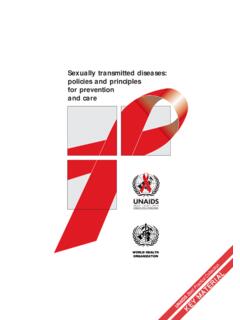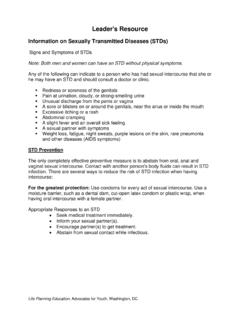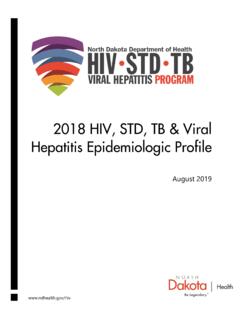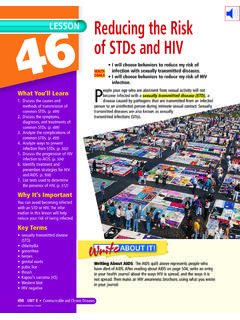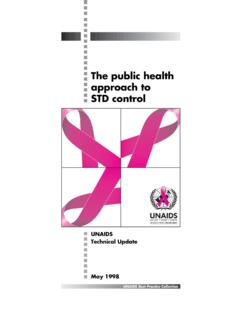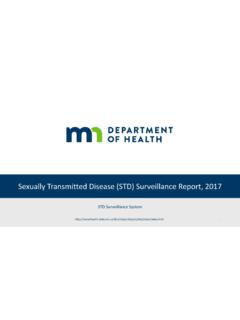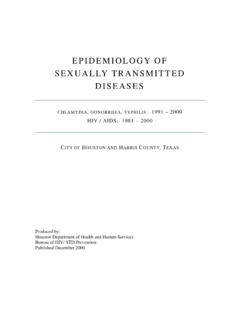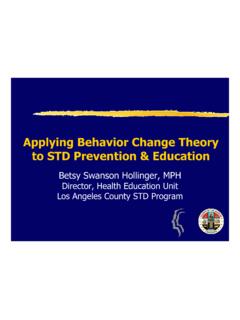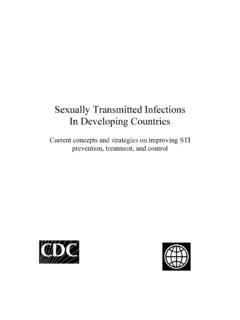Transcription of Managing STDs in the Correctional Setting: A …
1 Managing stds inthe Correctional Setting: A Guide for Clinicians2nd EditionHsu Jolin MillerLincoln Lubelczyk NijhawanManaging stds in the Correctional Setting: A Guide for Clinicians 2nd Edition Katherine K. Hsu, MD, MPH, FAAP Director, Ratelle STD/HIV Prevention Training Center of New England Medical Director, Division of STD Prevention Massachusetts Department of Public Health, Jamaica Plain, MA Assistant Professor of Pediatrics, Boston University Medical Center Kathryn M. Jolin, RN, BSN, CCHP Graduate Student, Psychiatric Mental Health Nursing William F. Connell School of Nursing, Boston College, Chestnut Hill, MA Jamie L. Miller, MPH Chair, Corrections Task Force National Coalition of STD Directors, Washington, Thomas Lincoln, MD, CCHP Medical Director, Hampden County Correctional Center, Ludlow, MA Assistant Professor of Medicine, Tufts University/Baystate Medical Center Rebecca A.
2 Lubelczyk, MD, CCHP, FSCP Associate Program Medical Director, University of Massachusetts Correctional Health Assistant Professor, Family and Community Health, University of Massachusetts Medical School Ank E. Nijhawan, MD, MPH Instructor, Harvard Medical School Department of General Internal Medicine and Primary Care Beth Israel Deaconess Medical Center, Boston, MA This guide was developed to assist clinicians in the prevention and management of stds in Correctional settings. It is meant to be a quick resource guide. We encourage users to consult additional references for more complete information. We welcome your feedback on this guide. Please send your comments to Second Edition, February 2011 Dedications and Acknowledgments We hope the second edition of this handbook will be helpful in Correctional health practice, and dedicate this handbook to all clinicians who work behind the walls.
3 We also dedicate the second edition to the memory of Dr. Sylvie Ratelle, co-author of the first edition of this handbook. We gratefully acknowledge the contributions of the following reviewers: Sharon Adler MD,MPH Clinical Instructor California STD/HIV Prevention Training Center Clinical Specialist, STD Control Branch, California Department of Public Health Alfred DeMaria, Jr., MD State Epidemiologist Massachusetts Department of Public Health Alison G. Muse, MPH Assistant Bureau Director Bureau of STD Prevention and Epidemiology, New York State Department of Health Sue Anne Payette, MS Coordinator NYS STD/HIV Prevention Oddslot Training Center Bureau of STD Prevention and Epidemiology, New York State Department of Health Laurie Reid, MS, RN Captain Public Health Service, Office of Health Equity, Division of HIV/AIDS Prevention, Centers for Disease Control and Prevention Devika Singh, MD, MPH Faculty Seattle STD/HIV Prevention Training Center, University of Washington This project was made possible through funding by the Centers for Disease Control and Prevention.
4 Managing stds in the Correctional Setting: A Guide for Clinicians 2nd Edition Table of Contents Chapter 1 Epidemiology & Screening Chapter 2 Diagnosis and Treatment of Traditional stds Frequently encountered sexually transmitted infections: signs and symptoms; diagnostic laboratory testing ; follow-up Important findings on physical exam and specimen collection Chapter 3 Algorithms of Diagnostic Assessment and Management of Syndromes Chapter 4 Vaccine Preventable stds Hepatitis A Hepatitis B HPV Vaccine resources Chapter 5 Sexual Assault in Corrections Chapter 6 Prevention and Public Health Topics Risk reduction counseling Partner services Health education Other methods of prevention Continuity of care Disease reporting Public health partnerships and resources Chapter 7 Appendices Appendix A Selected websites Appendix B Public health department STD program contacts (members of the National Coalition of STD Directors)
5 Appendix C Patient handouts Chapter 1 Managing stds in the Correctional Setting: A Guide for Clinicians Chapter One: Epidemiology and Screening Recommendations Page 1 of 5 Chapter One: Epidemiology and Screening Recommendations Sexually transmitted diseases ( stds ) cause a range of health problems, from mild acute illness to serious long term consequences including: infertility, ectopic pregnancy, chronic pelvic pain, cancer, liver disease, nervous system damage, disease and death of the newborn, increased transmission of HIV (though also an STD, HIV is beyond the scope of this guide), and more. By definition, stds occur in networks of sexually interactive individuals and require treatment on both the individual and population level.
6 stds are frequently asymptomatic but cause significant morbidity for the prisoner, his/her sexual partners, their babies and the community. Given that many of these high risk individuals have not, or could not, access health care in the community, incarceration provides an important opportunity to screen for and treat stds , which should not be missed1 Early detection, comprehensive treatment, continuity or care, prevention, education, and gathering data to guide care are basic components of public health STD care for Correctional EPIDEMIOLOGY stds account for four of the top five nationally notifiable diseases reported to the Centers for Disease Control and Prevention (CDC),3 and are more prevalent in corrections populations than in the general population.
7 Characteristics markedly associated with incarceration and increased STD risk overlap: age, racial/ethnic minority and socioeconomic status, residence in areas with higher STD and arrest prevalence, and poor access to medical care. STD risk behaviors are more common in juvenile4 and adult Correctional populations. STD rates in corrections vary considerably by locale and, as in the general population, STD rates risk behaviors also vary by demographics. Chlamydia and gonorrhea screening data from multiple Correctional facilities reported to the CDC (with some denominator variation in testing across facilities) are illustrated by age, gender, and juvenile/adult facility (see figure below).
8 The range is even more varied across various studies in different geographic locations. The majority of those infected do not report symptoms, as illustrated at three juvenile facilities where adolescent boys testing positive for chlamydial infection, approximately 97% did not report symptoms; of adolescent boys positive for gonorrhea, 93% did not report symptoms. 5 Syphilis rates have declined over the decades to a fraction of the rates of chlamydia and gonorrhea. Because of the difficulty of defining active cases of reported syphilis, tracking has followed primary and secondary (P&S) syphilis as a subset of active, more infectious, disease. In the Correctional and general population6, syphilis affects a slightly older population than chlamydia, peaking in 20-24 years-old and also varies substantially by race/ethnicity, and markedly by jurisdiction.
9 Syphilis is more common in jails located in communities with high rates among Managing stds in the Correctional Setting: A Guide for Clinicians Chapter One: Epidemiology and Screening Recommendations Page 2 of 5 Trichomoniasis is highly prevalent in women, including women older than for the bacterial stds , consistent with a recent study from San Francisco County Jail which found rates of 25% in women 18-25 years-old, 38% in women 26-35 years-old, and 2% in men across age Figure: Chlamydia & Gonorrhea Positivity by Age and Sex, Corrections Facilities, 2009 Juvenile Chlamydia Gonorrhea Adult *2009 STD Surveillance Report: Special Focus Profiles: Persons Entering Correctional Facilities6 SCREENING1 In the CDC 2010 STD Treatment Guidelines9, persons in Correctional facilities have been added as a special population.
10 The guidelines state: Universal screening of adolescent females for chlamydia and gonorrhea should be conducted at intake in juvenile detention or jail facilities. Universal screening of adult females should be conducted at intake among adult females up to 35 years of age (or on the basis of local institutional prevalence data). Universal screening should be conducted on the basis of the local area and institutional prevalence of early (primary, secondary, and early latent) infectious syphilis. The screening of sexually active young men should be considered in clinical settings with a high prevalence of chlamydia ( Correctional facilities). 1 Routine HIV testing is also highly recommended in Correctional settings, but outside the scope of this guide.

